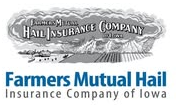There are two basic types of coverage - Yield Protection (YP) with a fixed price - or Revenue Protection (RP) which also protects bushel prices. Either plan uses your own crop yield averages (your APH) - and both use a base price established from the CBOT - a month long average of the closes for corn and bean fall contracts during February. The Revenue (RP) plans take the coverage a step further by guaranteeing a minimum income based on those February prices. As an example, let's say your corn APH was 160 bu/a and you elected 75% RP, using the real 2025 numbers: that base (Feb.) price for com was $4.70 per bushel - your bushel guarantee would be a minimum of the 120 bu/a with either YP or RP coverage. Under YP, a claim would be paid on the bushels you are short times the $4.70 price. The Revenue coverage just takes it a step further - the 75% level would guarantee you the 120 bu. times $4.70 - or a minimum of $564 per acre. As we all know, prices dropped during harvest, and the Harvest price (set from the same fall CBOT contracts as February using every trading day close during October) was $4.22 per bushel. Very simply, it took 133.6 of the cheaper bushels to get to your $564 guarantee. Please note: if that harvest price had come in higher – says $5.00 per bushel – your guarantee would have risen to $600 per acre – with no change in premium.
AGAIN – WE HIGHLY RECCOMEDND THESE REVENUE PLANS.
ENTERPRISE UNITS – EU
In recent years, the subsidy structure has changed, making the rates for EU far cheaper than the previous Optional Units (OU) plans. Under the OU coverage you could have a loss paid on just a portion of your crop – either by section or farm serial number depending on your county. You can read into this however you’d like, but several years back, the premium discount for the EU option was drastically increased– making it far cheaper to insure your crop as a whole under EU. At the end of the day, we agree that is what producers are looking for – more coverage at a cheaper premium. As a significant side effect, we're sure that the claims process has become more straight forward and accurate with the fewer units to consider – and we would assume there is less fraud and abuse of the system. Regardless of how we got here, the vast bulk of our coverage is written at the 75 or 80% level with an RP coverage, and EU structure.
As a side-bar to the BBB (Trump’s Big Beautiful Bill) we’re told that the premium subsidies will be further reduced for 2026, especially at the 80 and 85% levels – stay tuned!! The plan will be to utilize our email contacts with insureds (contact us if you are not on our lists) – in hope of keeping you informed of any changes. Ultimately, final rates and quotes will be “snail mailed” along with policy forms as soon as we are comfortable with the price discovery – very early March at the latest. Please note that changes need to be made no later than 15 March 2026 - or you’ll retain your current (2025) level/plan of coverage.

